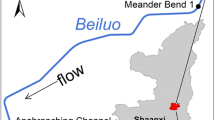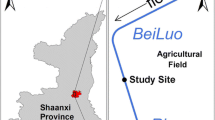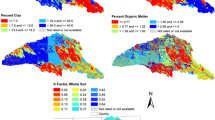Abstract
The change of vertical hydraulic conductivity (K v) before and after a flood season is crucial in understanding the long-term temporal variation of streambed permeability. Therefore, in this study, a detailed K v field investigation was conducted at an in-channel site within the Dawen River, China, before and after a flood season. In-situ falling-head permeameter tests were performed for the determination of K v. The tests were conducted using a 10 × 10 grid, at five different depths. In total, 871 valid K v values from layers 1–5 were obtained. The Kruskal-Wallis test on these K v values before and after the flood season shows they belonged to different populations. The sediments before the flood season primarily consisted of sand and gravel, whereas after the flood season, patchy distribution of silt/clay occurred in the sandy streambed and silt/clay content increased with the increasing depth; under the losing condition during flooding, downward movement of water brought fine particles into the coarse sediments, partially silting the pores. Accordingly, the K v values after the flood season had a smaller mean and median, and a higher level of heterogeneity, compared to those before the flood season. Additionally, the distribution pattern in K v across the stream differed before and after flood season; after the flood season, there was an increasing trend in K v from the south bank to the north bank. Overall, the contrasts of K v before and after the flood season were predominantly subject to the infiltration of fine particles.
Résumé
Le changement de conductivité hydraulique vertical (K v) avant et après une saison de crues est essentiel pour la compréhension de la variation temporelle à long terme de la perméabilité d’un lit de cours d’eau. Par conséquent, dans cette étude, une investigation approfondie du champ de K v a été menée sur un chenal de la rivière Dawen, Chine, avant et après la saison des crues. Des essais in situ de perméamètres ont été effectués afin de déterminer K v. Les tests in situ ont été réalisés en utilisant une grille de 10 × 110, à cinq profondeurs différentes. Ce sont au total 871 valeurs valides de K v pour les 5 niveaux qui sont obtenues. Le test de Kruskal-Wallis appliqué à ces valeurs de K v avant et après la saison des crues indique qu’elles appartiennent à des populations différentes. Les sédiments avant la saison des crues sont composés principalement de sable et de gravier, tandis que, après la saison des crues, la distribution inégale de limons / argile prend place dans le lit de la rivière sableux et la teneur en limons / argile augmente avec l’augmentation de la profondeur; sous conditions de perte, lors des crues, le mouvement descendant de l’eau apporte de fines particules dans les sédiments grossiers, avec un envasement partielle des pores. En conséquence, les valeurs de K v après la saison des crues ont une moyenne et médiane plus petite, et un niveau plus élevé d’hétérogénéité, par rapport à celles d’avant la saison des crues. En outre, le modèle de distribution de K v à travers le cours d’eau diffère avant et après la saison des inondations ; après la saison des crues, on observe une tendance à l’augmentation de K v de la rive sud à la rive nord. Dans l’ensemble, les contrastes de K v avant et après la saison des crues sont majoritairement soumis à l’infiltration des particules fines.
Resumen
El cambio en la conductividad hidráulica vertical (K v) antes y después de una estación de inundaciones es crucial para entender la variación temporal a largo plazo de la permeabilidad del cauce de un río. Por lo tanto, en este estudio, se realiza una detallada investigación de campo de K v en un sitio del canal en el río Dawen, China, antes y después de una estación de inundaciones. Se realizaron pruebas in situ de la caída de carga con permeámetros para la determinación de K v. Las pruebas se llevaron a cabo utilizando una malla de 10 × 110, a cinco diferentes profundidades. Se obtuvieron un total de 871 valores válidos de K v a partir de las capas 1 a 5. Los ensayos de Kruskal-Wallis sobre estos valores K v antes y después de la estación de las inundaciones muestran que ellos pertenecen a diferentes poblaciones. Los sedimentos antes de la estación de inundaciones consistieron básicamente de arena y grava, mientras que después de la estación de inundaciones, se produjo una distribución en parches de limo / arcilla en el cauce y el contenido de limo / arcilla aumentó con el aumento de la profundidad; bajo la condición de pérdidas durante las inundaciones, un movimiento descendente del agua transportó partículas finas dentro de los sedimentos gruesos, colmatando parcialmente los poros. En consecuencia, los valores de K v después de la estación de inundaciones tuvieron una media y mediana menores, y un nivel más alto de heterogeneidad, en comparación con aquellos previos a la estación de inundaciones. Además, el esquema de distribución en K v a través del cauce resultó diferente antes y después de la estación de inundaciones; después de la estación de inundaciones, hubo una tendencia creciente en K v desde la margen sur hacia la margen norte. En total, los contrastes de K v antes y después de la estación de inundaciones estuvieron predominantemente sujetos a la infiltración de partículas finas.
摘要
汛期前后河床垂向渗透系数(K v)对比分析对于理解河床渗透性长期时变特征具有十分重要的作用。因此,本文采用水头下降竖管渗透试验法对中国大汶河汛期前后河道河床五层沉积物K v做了试验研究,该试验是基于10 × 10网格,共获得871个有效K v值。采用Kruskal-Wallis法对汛期前后渗透系数值做相似性检验,结果表明他们有统计学差异。汛期前试验期间河床沉积物主要由沙和砾石组成,而汛期后,大量粉沙和黏土分布于河床浅层,且粉沙和黏土含量随深度增加而减少,这可能是和汛期河流补给地下水,河水携带细颗粒物质进入河床而阻塞空隙有关。相应地,相比于汛期前,汛期后河床沉积物K v平均值和中值更小,非均质性更大。汛期前后河床沉积物K v在垂直于河道方向上有差异,汛期后K v从南岸到北岸有增大的趋势。总之,汛期前后河床沉积物K v存在显著差异,且差异性主要受汛期细颗粒物质沉积的影响。
Resumo
A mudança da condutividade hidráulica vertical (K v) antes e após uma temporada de cheia é crucial para o entendimento da variação da permeabilidade de leitos de rio a longo prazo. Nesse sentido, o presente estudo realizou uma investigação de campo da K v em detalhe em um canal interior entre o Rio Dawen na China, antes e após a temporada de cheia. Ensaios de perda de carga hidráulica com permeâmetros foram realizados in-situ a fim de determinar a K v. Os ensaios foram realizados utilizando uma malha de 10 × 110 em cinco profundidades diferentes. No total, foram obtidas 871 medidas representativas de K v entre as camadas 1 e 5. O teste de Kruskal-Wallis aplicado às medidas de K v antes e após a temporada de cheia indica que as mesmas pertencem a populações distintas. Os sedimentos anteriores à temporada de cheia consistiram essencialmente em areia e cascalho, enquanto que os sedimentos após a temporada de cheia indicaram uma distribuição esparsa de silte/argila no leito de rio arenoso além do aumento do conteúdo de silte/argila conforme o aumento da profundidade. Em condições de descompactação durante a cheia, o fluxo de água vertical transportou partículas finas entre os sedimentos grossos, preenchendo os poros parcialmente. De maneira semelhante, as medidas da K v após a temporada de cheia tiveram média e mediana menores, e um maior nível de heterogeneidade, em comparação às medidas anteriores a temporada de cheia. Adicionalmente, o padrão de distribuição da K v ao longo do canal mudou entre antes e após a temporada de cheia. Após a temporada de cheia, houve uma tendência de aumento da K v a partir da margem sul até a margem norte. De modo geral, os contrastes da K v entre antes e após a temporada de cheia estiveram predominantemente sujeitos a infiltração de partículas finas.











Similar content being viewed by others
References
Blaschke AP, Steiner K, Schmalfuss R, Gutknecht D, Sengschmitt D (2003) Clogging processes in hyporheic interstices of an impounded river, the Danube at Vienna, Austria. Int Rev Hydrobiol 88(3–4):397–413
Brunke M (1999) Colmation and depth filtration within streambeds: retention of particles in hyporheic interstices. Int Rev Hydrobiol 84(2):99–117
Chen X (2000) Measurement of streambed hydraulic conductivity and its anisotropy. Environ Geol 39(12):1317–1324
Chen X (2004) Streambed hydraulic conductivity for rivers in south-central Nebraska. J Am Water Resour Assoc 40(3):561–573
Chen X (2005) Statistical and geostatistical features of streambed hydraulic conductivities in the Platte River, Nebraska. Environ Geol 48:693–701
Chen X (2011) Depth-dependent hydraulic conductivity distribution patterns of a streambed. Hydrol Proc 25:278–287
Chen X, Ayers JF (1998) Aquifer properties determined from two analytical solutions. Ground Water 36(5):783–791
Chen X, Dong W, Ou G, Wang Z, Liu C (2013) Gaining and losing stream reaches have opposite hydraulic conductivity distribution patterns. Hydrol Earth Syst Sci 17:2569–2579
Cheng C, Song J, Chen X, Wang D (2011) Statistical distribution of streambed vertical hydraulic conductivity along the Platte River, Nebraska. Water Resour Res 25:265–285
Cheong J, Hamm S, Kim H, Ko E, Yang K, Lee J (2008) Estimating hydraulic conductivity using grain-size analyses, aquifer tests, and numerical modeling in a riverside alluvial system in South Korea. Hydrogeol J 16(6):1129–1143
Davis RA (1983) Depositional systems. Prentice-Hall, Englewood Cliffs, NJ, pp 7–10
Descloux S, Datry T, Marmonier P (2013) Benthic and hyporheic invertebrate assemblages along a gradient of increasing streambed colmation by fine sediment. Aquat Sci 75(4):493–507
Dong W, Chen X, Wang Z, Ou G, Liu C (2012) Comparison of vertical hydraulic conductivity in a streambed-point bar system of a gaining stream. J Hydrol 450–451:9–16
Ford TE, Lock MA (1985) A temporal study of colloidal and dissolved organic carbon in rivers: apparent molecular weight spectra and their relationship to bacterial activity. OIKOS 45:71–78
Freeze RA, Cherry JA (1979) Groundwater. Prentice-Hall, Englewood Cliffs, NJ, 604 pp
Genereux DP, Leahy S, Mitasova H, Kennedy CD (2008) Spatial and temporal variability of streambed hydraulic conductivity in West Bear Creek, North Carolina, USA. J Hydrol 358:332–353
Goswami D, Kalita PK, Mehnert E (2010) Modeling and simulation of baseflow to drainage ditches during low-flow periods. Water Resour Manag 24:173–191
Hancock PJ (2002) Human impacts on the stream-groundwater exchange zone. Environ Manag 29:763–781
Hatch CE, Fisher AT, Ruehl CR, Stemler G (2010) Spatial and temporal variations in streambed hydraulic conductivity quantified with time-series thermal methods. J Hydrol 389:276–288
Hvorslev MJ (1951) Time lag and soil permeability in groundwater investigation. US Army Corps Eng Waterw Exp Station Bull 36:1–50
Kaleris V (1998) Quantifying the exchange rate between groundwater and small streams. J Hydraul Res 36(6):913–932
Kelly SE, Murdoch LC (2003) Measuring the hydraulic conductivity of shallow submerged sediments. Ground Water 41(4):431–439
Landon MK, Rus DL, Harvey FE (2001) Comparison of instream methods for measuring hydraulic conductivity in sandy streambeds. Ground Water 39(6):870–885
Leek R, Wu J, Wang L, Hanrahan TP (2009) Heterogeneous characteristics of streambed saturated hydraulic conductivity of the Touchet River, southeastern Washington, USA. Hydrol Process 23:1236–1246
Levy J, Birck MD, Mutiti S, Kilroy KC, Windeler B, Idris O, Allen LN (2011) The impact of storm events on a riverbed system and its hydraulic conductivity at a site of induced infiltration. J Environ Manag 92:1960–1971
Lu C, Chen X, Ou G, Cheng C, Shu L, Cheng D, Appiah-Adjei EW (2012) Determination of the anisotropy of an upper streambed layer in east-central Nebraska, USA. Hydrogeol J 20:93–101
Mutiti S, Levy J (2010) Using temperature modeling to investigate the temporal variability of riverbed hydraulic conductivity during storm events. J Hydrol 388:321–334
Nowinski JD, Cardenas MB, Lightbody AF (2011) Evolution of hydraulic conductivity in the floodplain of a meandering river due to hyporheic transport of fine materials. Geophys Res Lett 38(1). doi:10.1029/2010gl045819
Packman AI, MacKay JS (2003) Interplay of stream-subsurface exchange, clay particle deposition and streambed evolution. Water Resour Res 39(4). doi:10.1029/2002WR001432
Ryan JN, Elimelech M (1996) Colloid mobilization and transport in groundwater. Colloid Surface A 107:1–56
Ryan RJ, Packman AI (2006) Changes in streambed sediment characteristics and solute transport in the headwaters of Valley Creek, an urbanizing watershed. J Hydrol 323(1–4):74–91
Ryan RJ, Boufadel MC (2007) Evaluation of streambed hydraulic conductivity heterogeneity in an urban watershed. Stoch Env Res Risk A 21(4):309–316
Sebok E, Duque C, Engesgaard P, Boegh E (2014) Spatial variability in streambed hydraulic conductivity of contrasting stream morphologies: channel bend and straight channel. Hydrol Process. doi:10.1002/hyp.10170
Song J, Chen X, Cheng C, Summerside S, When F (2007) Effects of hyporheic processes on streambed vertical hydraulic conductivity in three rivers of Nebraska. Geophys Res Lett 34. doi:10.1029/2007gl029254
Song J, Chen X, Cheng C, Wang D, Susan L, Xu Z (2009) Feasibility of grain-size analysis methods for determination of vertical conductivity of streambed. J Hydrol 375:428–437
Springer AE, Petroutson WD, Semmens BA (1998) Spatial and temporal variability of hydraulic conductivity in active reattachment bars of Colorado River, Grand Canyon. Ground Water 37(3):338–344
Tonina D, Luce C, Gariglio F (2014) Quantifying streambed deposition and scour from stream and hyporheic water temperature time series. Water Resour Res 50:287–292
Xue Y (1997) Groundwater dynamics (in Chinese), 2nd edn. Geological Publishing House, Beijing
Zhu JS, Shu LC, Lu CP (2013) Study of heterogeneity characteristics of vertical hyporheic flux using a heat tracing method (in Chinese). J Hydraul Eng 44(7):818–825
Acknowledgements
This research was supported by the National Natural Science Foundation of China (41201029), the Colleges and Universities in Jiangsu Province Plans to Graduate Research and Innovation (2014B35714), the National Natural Science Foundation of China (41172203), Specialized Research Fund for the Doctoral Program of Higher Education of China (20120094120019), China Postdoctoral Science Foundation (2013 M540410), and the Open Research Fund of State Key Laboratory of Simulation and Regulation of Water Cycle in River Basin (China Institute of Water Resources and Hydropower Research, IWHR - SKL - 201502). The authors thank the anonymous reviewers and editors for their valuable comments, which helped improve the quality of the manuscript significantly.
Author information
Authors and Affiliations
Corresponding author
Rights and permissions
About this article
Cite this article
Wu, G., Shu, L., Lu, C. et al. Variations of streambed vertical hydraulic conductivity before and after a flood season. Hydrogeol J 23, 1603–1615 (2015). https://doi.org/10.1007/s10040-015-1275-9
Received:
Accepted:
Published:
Issue Date:
DOI: https://doi.org/10.1007/s10040-015-1275-9




